The popular LM317 voltage regulator IC is designed to deliver not more than 1.5 amps, however by adding an outboard current boost transistor to the circuit it becomes possible to upgrade the regulator circuit to handle much higher currents, and upto any desired levels.
You might have already come across the 78XX fixed voltage regulator circuit which are upgraded to handle higher currents by adding an outboard power transistor to it, the IC LM317 is no exception and the same can be applied for this versatile variable voltage regulator circuit in order to upgrade its specs for handling massive amounts of current.
The Standard LM317 Circuit
The following image shows standard IC LM317 variable voltage regulator circuit, using a bare minimum of components in the form of a single fixed resistor, and a 10K pot.
This set up is supposed to offer a variable range of zero to 24V with an input supply of 30V.
However if we consider the current range, it's not more than 1.5 amps regardless of the input supply current, since the chip is internally equipped to allow only up to 1.5 amps and inhibit anything that may be demanding above this limit.

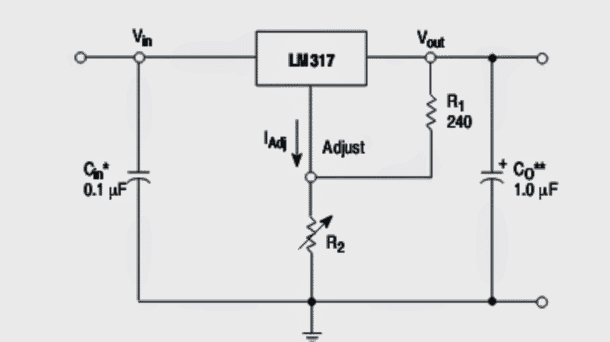
The above shown design which is limited with a 1.5 amp max current can be upgraded with an outboard PNP transistor in order to boost the current on par with the input supply current, meaning once this upgrade is implemented the above circuit will retain its variable voltage regulation feature yet will be able to offer the full supply input current to the load, bypassing the IC's internal current limiting feature.
Calculating the Output Voltage
For calculating the output voltage of a LM317 power supply circuit the following formula could be used
VO = VREF (1 + R2 / R1) + (IADJ × R2)
where is = VREF = 1.25
Current ADJ can be actually ignored since it is usually around 50 µA and therefore too negligible.
Adding an Outboard Mosfet Booster
This current boost upgrade can be implemented by adding an outboard PNP transistor which may be in the form of a power BJT or a P-channel mosfet, as shown below, here we use a mosfet keeping things compact and allow a huge current upgrade in the specs.
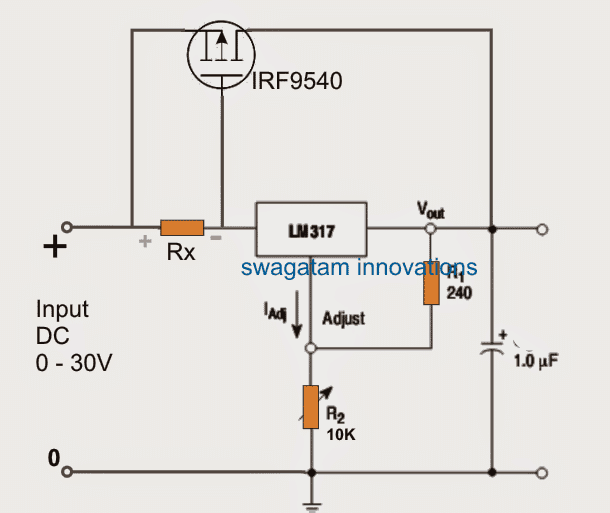
In the above design, Rx becomes responsible for providing the gate trigger for the mosfet so that it's able to conduct in tandem with the LM317 IC and reinforce the device with the extra amount of current as specified by the input supply.
Initially when power input is fed to the circuit, the connected load which could be rated at much higher than 1.5 amps tries to acquire this current through the LM317 IC, and in the process a proportionate amount of negative voltage is developed across RX, causing the mosfet to respond and switch ON.
As soon as the mosfet is triggered the entire input supply tends to flow across the load with the surplus current, but since the voltage also begins to increase beyond the LM317 pot setting, causes the LM317 to get reverse biased.
This action for the moment switches OFF the LM317 which in turn shuts off the voltage across Rx and the gate supply for the mosfet.
Therefore the mosfet too tends to switch OFF for the instant until the cycle perpetuates yet again allowing the process to sustain infinitely with the intended voltage regulation and high current specs.
Calculating MOSFET Gate Resistor
Rx may be calculated as given under:
Rx = 10/1A,
where 10 is the optimal mosfet triggering voltage, and 1 amp is the optimal current through the IC before Rx develops this voltage.
Therefore Rx could be a 10 ohm resistor, with a wattage rating of 10 x 1 = 10 watt
If a power BJT is used, the figure 10 can be replaced with 0.7V
Although the above current boost application using the mosfet looks interesting, it has a serious drawback, as the feature completely strips off the IC from its current limiting feature, which can cause the mosfet to blow-of or get burnt in case the output is short circuited.
To counter this over-current or short-circuit vulnerability, another resistor in the form of Ry may be introduced with the source terminal of the mosfet as indicated in the following diagram.
The resistor Ry is supposed to develop a counter voltage across itself whenever the output current is exceeded above a given maximum limit such that the counter voltage at the source of the mosfet inhibits the gate triggering voltage of the mosfet forcing a complete shut off for the mosfet, and thus preventing the mosfet from getting burnt.

This modification looks pretty simple, however calculating Ry could be little confusing and I do not wish to investigate it deeper since I have a more decent and a reliable idea which can be also expected to execute a complete current control for the discussed LM317 outboard boost transistor application circuit.
Using a BJT for Current Control
The design for making the above design equipped with a boost current and also a short circuit and overload protection can be seen below:
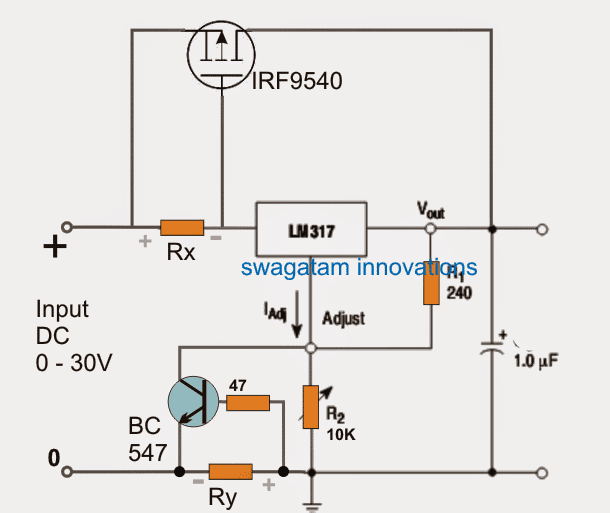
An couple of resistors, and a BC547 BJT is all that may be required for inserting the desired short circuit protection to the modified current boost circuit for the LM317 IC.
Now calculating Ry becomes extremely easy, and may be evaluated with the following formula:
Ry = 0.7/current limit.
Here, 0.7 is the triggering voltage of the BC547 and the "current limit" is the maximum valid current that may specified for a safe operation of the mosfet, let's say this limit is specified to be 10amps, then Ry can be calculated as:
Ry = 0.7/10 = 0.07 ohms.
watts = 0.7 x 10 = 7 watts.
So now whenever the current tends to cross the above limit, the BC547 conducts, grounding the ADJ pin of the IC and shutting off the Vout for the LM317
Using BJTs for the Current Boost
If you are not too keen on using mosfet, in that case you could probably apply BJTs for the required current boosting as shown in the following diagram:
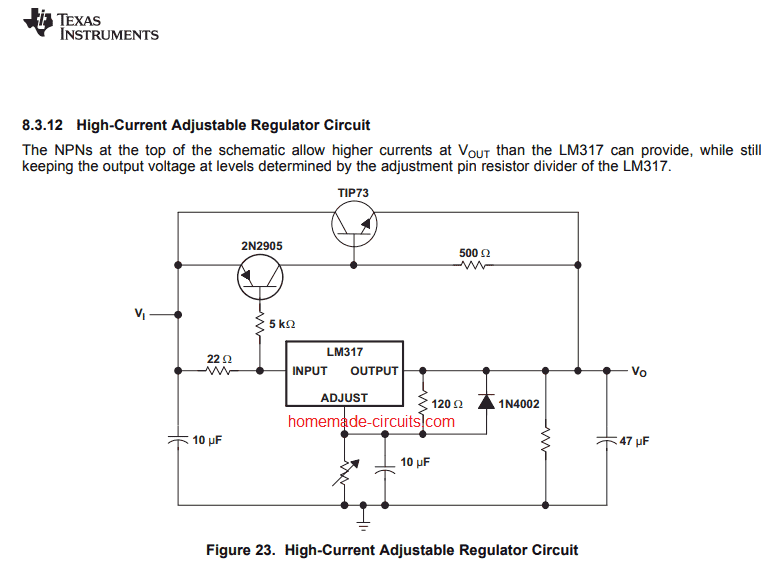
Courtesy: Texas Instruments
Adjustable Voltage/Current LM317 High Current Regulator
The following circuit shows a highly regulated LM317 based high current power supply, which will provide an output current of over 5 amps, and a variable voltage from 1.2 V to 30 V.
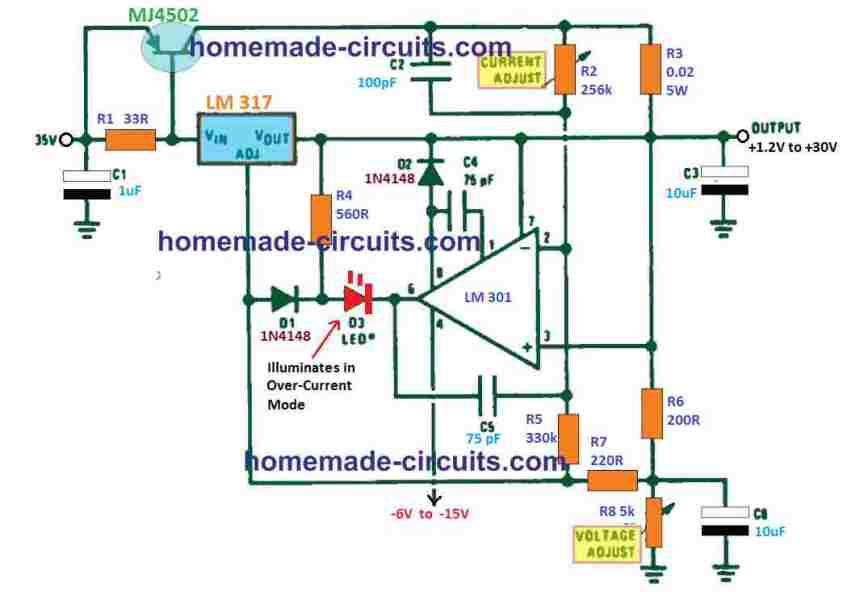
In the figure above we can see that the voltage regulation is implemented in the standard LM317 configuration through R6 pot which is connected with the ADJ pin of the LM317.
However, the op amp configuration is specifically included to feature the useful a full scale high current adjustment ranging from the minimum to the maximum 5 Amp control.
The 5 amp high current boost available from this design can be further increased to 10 amps by suitably upgrading the MJ4502 PNP outboard transistor.
The inverting input pin#2 of the op amp is used as reference input which is set by the pot R2.
The other non-inverting input is used as the current sensor. The voltage developed across R6 through the current limiter resistor R3 is compared with the R2 reference which allows the output of the op amp to become low as soon the maximum set current is exceeded.
The low output from the op amp grounds the ADJ pin of the LM317 shutting it off and also the output supply, which in turn quickly reduces the output current and restores the LM317 working.
The continuous ON/OFF operation ensures that the current is never allowed to reach above the set threshold adjusted by R2.
The maximum current level can be also modified by tweaking the value of the current limit resistor R3.
Another High Current LM317 circuit with Adjustable Current Circuit
The following design also depicts an LM317 device configured with an external outboard transistor for achieving an enhanced high current output.
However, this circuit includes an improved current control feature, which is fully adjustable through a preset.
The idea is actually simple. Resistor R2 is rigged as the current sensor resistor.
When the output current exceeds the desired maximum limit, a proportionately increased potential is developed across the resistor R2.
This current is applied to the base T2, depending on the setting of the preset P1.
When this happens, T2 conducts and supplies the required base bias to the attached BC547 transistor.
The BC547 now begins conducting thereby grounding the ADJ pin of the LM317.
This causes the LM317 to shut down, and prevent the output current from exceeding any further.
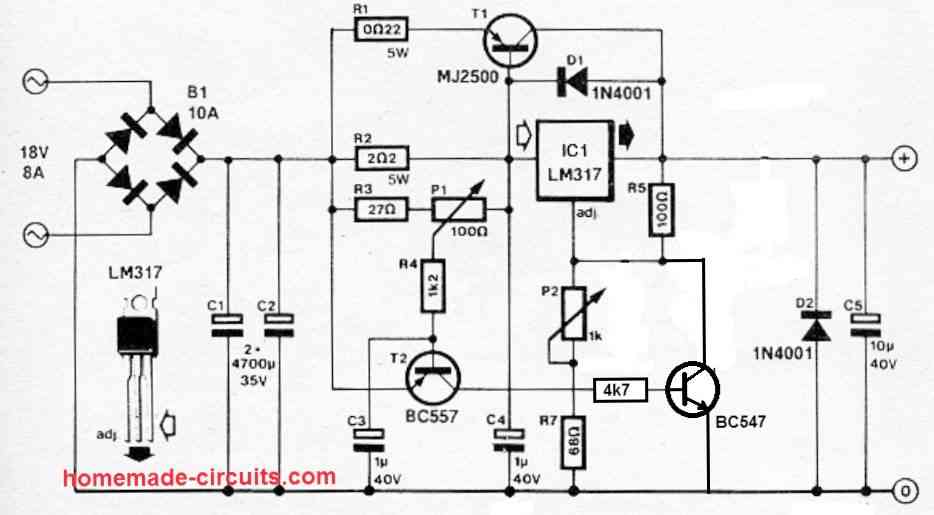
Using 6nos of 2N3055 to generate 20 amp current Output
Another very simple high current LM317 variable power supply can be built by connecting a few power transistors like 2N3055 in emitter follower configuration with the output of a standard LM317 power supply circuit as shown below.
The following design was contributed to this site by one of the avid readers of this blog, Mr. Moe through email.
Here's the details of the email as given below:
I have studied all your LM317 based power supply projects and have I have learned a lot from your wonderful posts. However; I assembled this very simple circuit below and it works very well. I would be very glad and thankful if you would please take a look at it to see if it is a perfect circuit or needs some modifications.
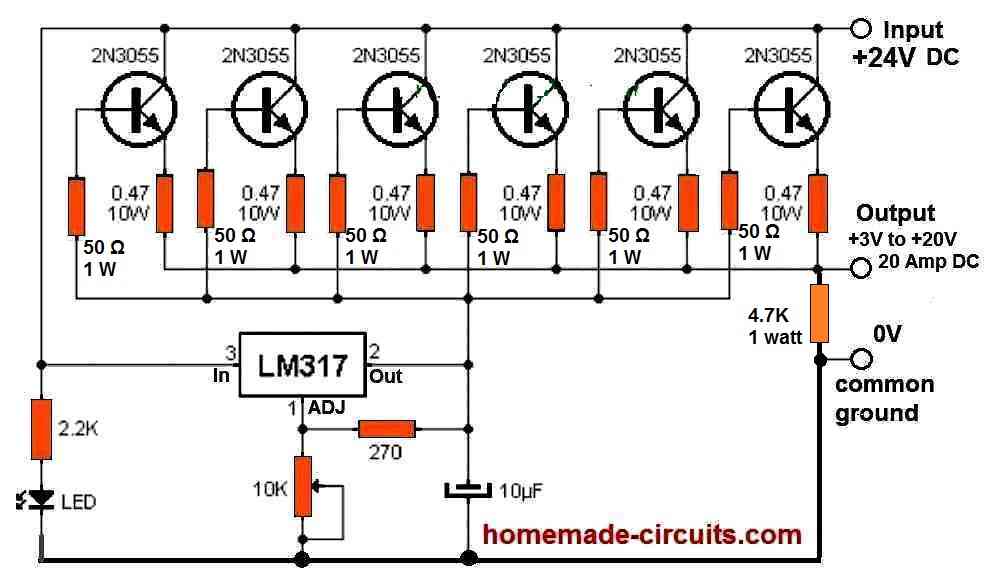
Using a Single 2N3055 with LM317 to Generate 5 amp output Current
The above high current LM317 power supply using a single 2N3055 transistor was successfully built and tested by Mr. Ersa, who is a avid reader of this blog.
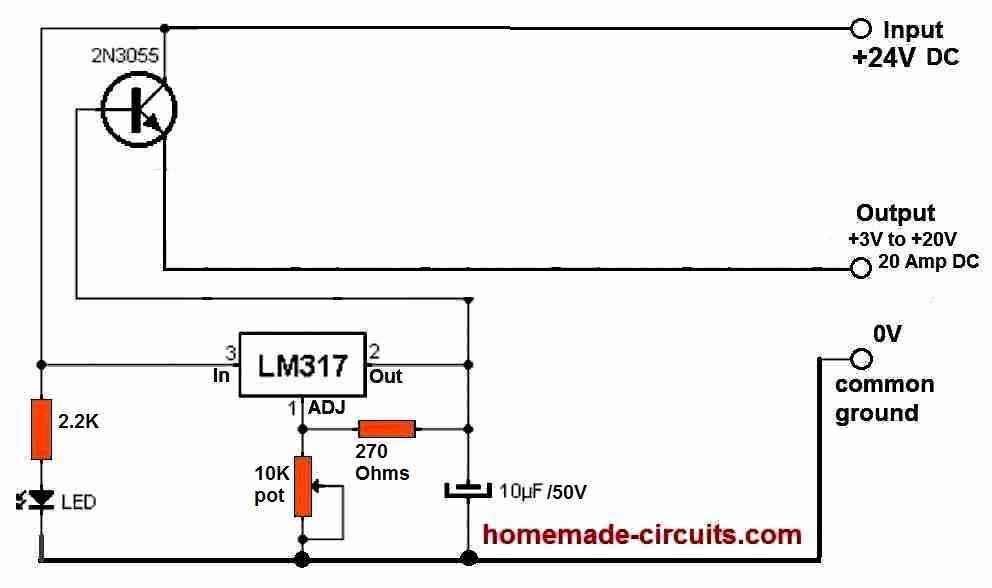
The following video test proof along with beautiful prototype images were contributed by Mr. Ersa:
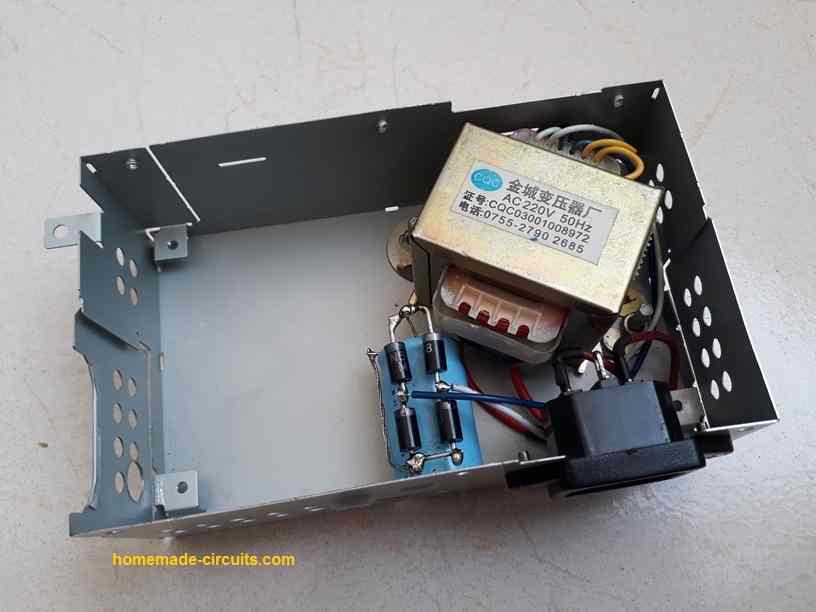
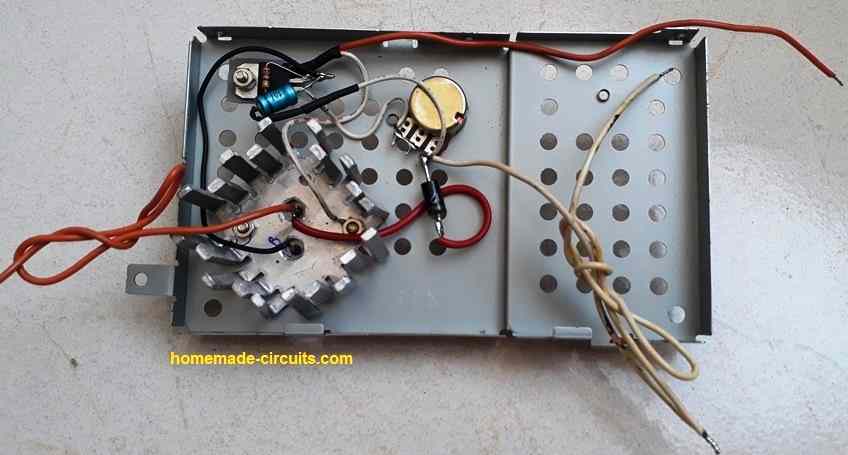
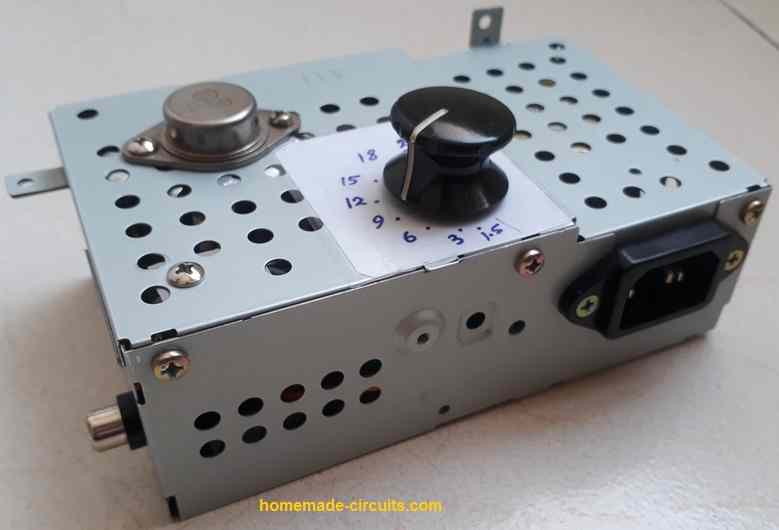
soy de cuba ing electrónico también,las explicaciones de sus diagramas están muy buenas.la pregunta que tengo es: Que onda es mejor para cargar una batería de auto, con CD o onda continua ?
Hi, a pulsed voltage is better than a continuous DC for charging a battery.
Just wonder how you can get 20A out from 2N3055 since the Continuous collector current rating of this transistor is only 15A!
Sorry, 20A is for the first circuit using 6 transistor, the second one with a single transistor can give at the most 3 amps only.
sir 2n3055 has 15amp max limit but why it can give only 2 amp as said by you in some comments.
Hello Josh,
At 2 amp you won’t need a heatsink for the 2n3055. Above 2 amp you may need to put a heatsink on the 2n3055 transistor.
As the current increases the heatsink will need to get bigger and bigger.
Beyond 10 amps the heatsink will need to be massive and might require fan cooling also.
Therefore, even though the max limit off the transistor is 15 amps, it will start getting hot after 2 or 3 amp range and the heat control will become crucial.
Hello,
I made the second last circuit with two 2n3055 transistors, but my output voltage is not stable at all.
For example if I set it to 7 volts and I draw 5 amps the output voltage drops at aprx. 5 volts.
I have an input voltage of 12 vdc at 13.5 amps.
Hi,
Please try reducing the base resistor to a lower value until the voltage drop is not too high. You may also need to do the same with the emitter resistors.
Thanks in advance, but can you help me to design a variable power supply scheme using the LM317T and ×3 TIP41C with the short protection feature (using BC547) for the following purposes:
1. Light to medium load testing (5A continuous).
2. Can be used as a 12V lead acid battery charger.
I’m interested in the LM317 schematic with the IRF9540 MOSFET you provided above. However, I don’t have IRF9540 MOSFET.
I’ve also seen the schematic of the LM317 you provided with the TIP73 transitor and also with this current limiting feature: " rel="ugc">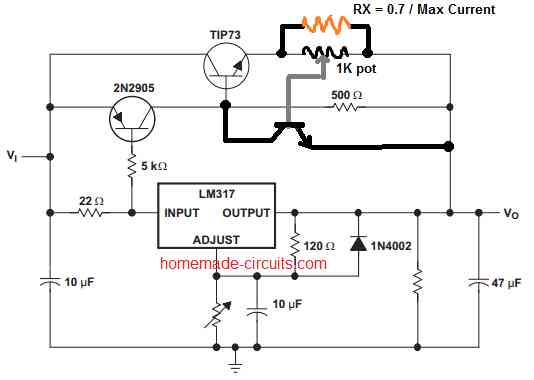 . But that’s using TIP73, while I only have ×3 TIP41C and also I’m stumped on how to parallelize it. Also, I want to ask about what is the function of the 1K ohm potentiometer in the schematic? can use 1 fixed resistor with a certain value?
. But that’s using TIP73, while I only have ×3 TIP41C and also I’m stumped on how to parallelize it. Also, I want to ask about what is the function of the 1K ohm potentiometer in the schematic? can use 1 fixed resistor with a certain value?
Thank You.
Edit: The input volatge is 25VDC and current ±8A.
Hi, you can try the second last circuit, which shows how to use 2N3055 in parallel for getting high current outputs. You can replace the 2N3055 with your TIP41 transistor.
In the linked diagram, the 1K pot is for adjusting the output current limit.
Hello sir! Can we use an N channel Mosfet such as IRFz44n or IRF9540N instead of BJT in the last diagram where 2N3055 is used? Such that source is connected to input supply, gate at output of LM317 and get high Amp output from Drain?
Hello Saad, A BJT will drop only 1 V at its emitter, whereas a MOSFET might drop upto 5 V at its source, that may be an issue.
hello swagatham, how to add remote sensing to LM317 with 1m long load wires? can we connect the R1 ,R2 feed back resistors near to load instead of at regulator? Thank you
Hello KV Ramana,
R1 and R2 must be near the IC, they cannot be added at a distance from the IC near the load. If your load is 1 meter away from the IC in that case you must use a filter capacitor across the load for proper regulation and elimination of noise. The capacitor can be a 470uF capacitor.
" rel="ugc">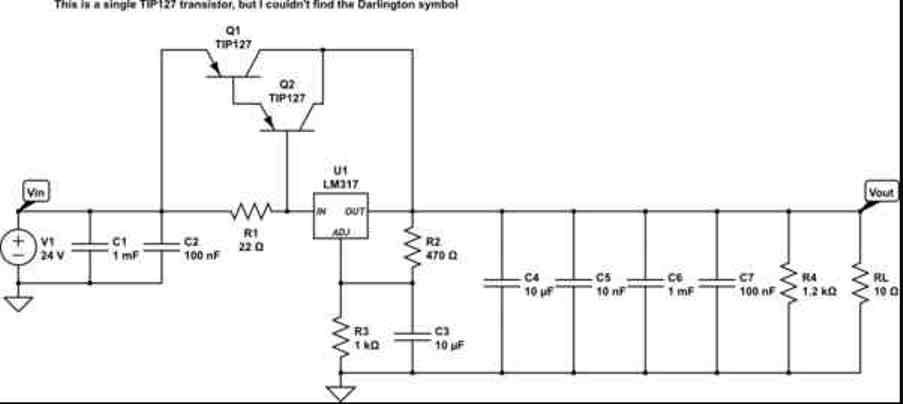
hi dear Swagatam
how to determine the amount of R1 in the above circuit ?
can we add a base resistor to the tip127 ?
Hi Khorshid,
The two transistors will require around 1.2 + 1.2 = 2.4 V to switch ON.
The current passing through R1 must generate 2.4V across R1. So this is the amount of current required to pass through LM317 so that a 2.4 is developed across R1. If you consider 1 amp to be allowed through R1, then:
R1 = 2.4 / 1 = 2.4 ohms
I think the calculation is already explained in the above article.
You can add a base resistor although it is not strictly required.
hi sir how can I boost a 0.08A 3v into 1
A 3v?
Hi Muktar, that is not possible.
If you increase the current then the voltage has to go down and vice versa.
Hello sir,
can we get a very low ripple of 1mv p to p with LM317 with current booster? The ripple rejection is given as 77 dB with 10uf across ADJ pin to GND? How to get ultra low ripple say less than 1mv p to p? Thanks sir!!!
Hello k.v.ramana rao, I am also not sure how to precisely generate the ripple voltage and what could be adjusted to fix lower than 1 mV peak to peak ripple. I guess capacitors connected across the input and output leads of the IC could be adjusted to achieve this. This might require some practical trial and error.
Good day sir, I have 4 power supplies for a 4 channel LM3886 amp. Unfortunately I purchased the wrong transformers, and was too late to return. I have 4 +42/-42DC @4.15 Amps supplies. I need +35/-35DC @4.15Amps for my project. Your LM317HV/LM338HV adjustable regulator would work with additional transistor for additional current. The Lm317/ LM338 regulator with transistor current boost, could I just substitute the HV version for the regular version? Or would additional circuitry be necessary? I need a symmetrical supply on 1 board so as to use 4 board’s, space being a big consideration, and cost, both not planned for in initial design. PLEASE HELP, I’m stuck at the moment with this. I’d like to have board’s made for this, so a gerber file would be so appreciated if possible. Thankyou for your time and for all I’ve learned on your site, your quite the engineer, and teacher. Andrew Cassel.
Hi Andrew,
Replacing the LM317 with the HV version and outboard transistor may be possible, but I am not sure about the negative IC LM337 replacement options or whether we have an HV version for this IC or not?
Instead, I think you can try a transistorized version which might give the same results without any fear of burning. You can perhaps try the following concept and see if it works for you or not:
https://www.homemade-circuits.com/0-to-50v-0-to10amp-variable-dual-power/
But this might consume a little more space.
Yes there is a negative HV version LM337HV. If I swap out the standard for HV with current boost there needn’t be any additional circuitry? What do you think of a buck converter with its higher efficiency? Can a buck converter be used in a symmetrical supply? Only seen single rail supply used with them. Again thanks for your time.
Sure, if you have a HV version for the negative supply IC then you can swap it with the standard version.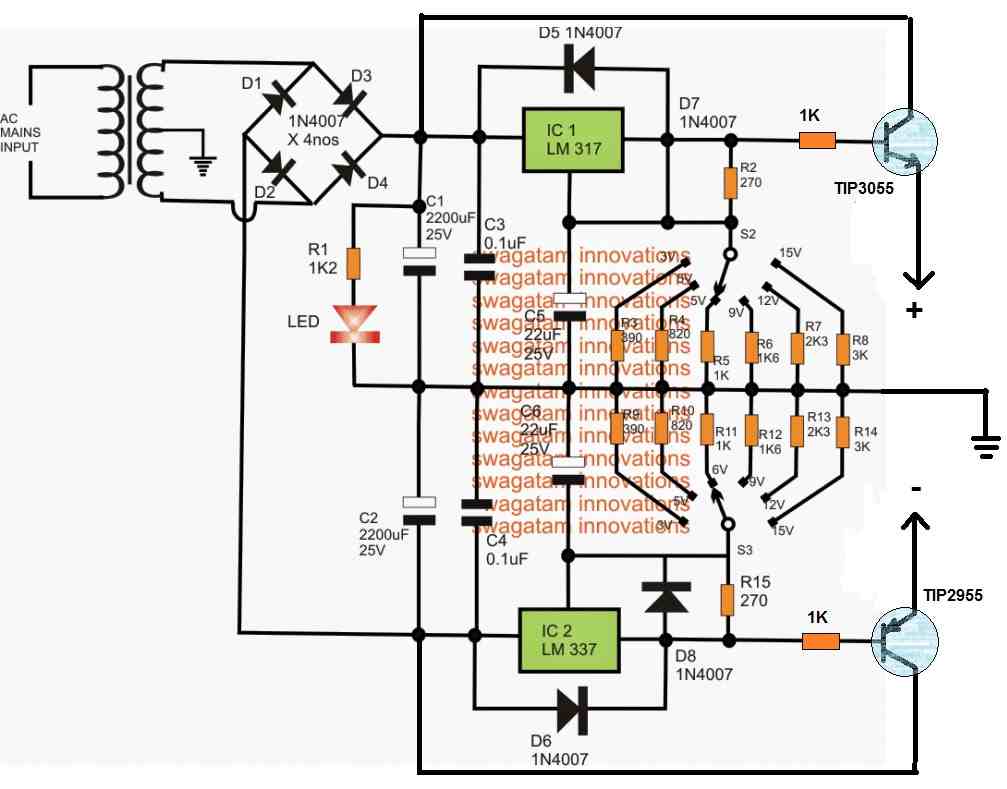
You can use a TIP2955 pnp transistor for boosting the negative current, as shown in the following diagram:
" rel="ugc">
I have also never seen a buck converter with symmetrical supplies, however I guess it should be possible to configure one.
Please note I construct mr. Eres circuit using lm317 and 2n3055 circuit. I used 19vdc input. Why is my adjustable voltage starts at 7vdc to 15vdc? Im expecting the voltagr oitput will start from zero to max voltage? Where do I go wrong? What I never installed is 2.2 k and LED? Does tgis affect the minimum voltage? Appreciate your help on this problem. Many thanks
Hi, how much voltage do you get across the output/ground of the LM317 IC. The IC LM317 output minimum voltage should be 1.25 V, which will turn into approximately 0.25 V at the emitter of the 2N3055 transistor. Please check these results across the two devices.
The LED/resistor has nothing to do with the output voltages of the circuits, so you can ignore it.
Let me know how it goes?
Muy interesante sitio web. Lo felicito. Siga adelante!!!…
Thank you!
hello sir
you are a superstar,
looking through your excellent pages: you renew my faith in humanity.
thank you for your refreshing, informative & inspirational take on electronics!
best regards from ireland,
stefan zalewski (ei4ku)
Thanks stefan, I appreciate your kind thoughts! Glad you liked the site!
Hi, sir. I would like to ask if you already encounter microbial fuel cell and a circuit for it to increase its current? Thanks.
SIR, if a small resistor is used in the o/p will it not degrade voltage regulation ? also if we use Ry resistor in the return path ,do we need two returns? one is i/p return and another is o/p return and in between current sense resistor comes… i have only one return pin available.. Tanks in advance…
Ramana, why do you want resistor at the output, since Rx and Ry are already present?
I did not understand your question actually?
sir, what will be the power dissipation of MOSFET?
It will depend on the load wattage and load current consumption.!
sirji,
i got to make a 12V 1.5A reg with 25V i/p in a small space. the reg works up to 16V i/p. after that the regulator goes into thermal shut down. i want to use two LM117 in parallel with a single control using a TL084 opamp as per application circuit ? do they share currents equally ?. the circuit using MOSFET , Rx power dissipation is high…which cant be get in small size. i think the mosfet works in linear region and dissipates more . dropout across drain and source x mosfet load current… which at 25v in will be high…but may prevent LM317 going into shutdown.i find LM317 with short circuit protection using BC547 with external booster using TIP 73 or TIP122 may be good for me. can you please advise ?
Hi Ramana, The LM317 and the mosfet both are linear devices and will dissipate a lot of heat whenever the input and output differential is high. The external transistor is not short circuit protected but LM317 is. No matter which circuit you use the transistor will heat up as the output DC is decreased to lower levels.
If you want a short circuit protected transostorized regulator, then you can refer to the following artcile:
How to Design a Bench Power Supply Circuit
To prevent transistor heating you can set up the input side DC with different ranges such as 6V, 12V, 18V, 24V etc, and toggle this input range along with the pot adjustment, depending on the output load requirement, so that output/input differential remains at manageable range and the transistors do not heat up
Thanks a lot !!! very nice to see your prompt reply!!
It is my pleasure!
Hello Swagatam,
I received your reply. Yes, I like the LM317, but I’d like to make a more general version, using a ‘booster’, so that I can control the output current up to 5 amps. It’s too bad that the LM196 TO-3 item is totally obsolete, since that would provide a very compact & simple solution. When I went to the TI website, plugged the LM196(K) into their search engine, it responded with a no data reply.
For my Stepper Motor Controller, it’s all packaged in a relatively small BUD box, with the Thumbwheel switches & the 7-segment displays mounted in place. I’d have to add a heatsink to one of the side faces & do the appropriate circuit modifications. I’d go with a MOSFET with a very low Rds to limit the i2r losses.
as it is now, the 4 IGFETs that I’m using as Motor drivers have a Rds of approx. 0.02 ohms.
None of this would be necessary IF I could find a NEMA 23 Unipolar Stepper Motor with a rated voltage of either 12 or 24, but so far I haven’t found any.
Hello Karl, did you try searching LM396, it is an equivalent of LM196? Alternatively you can also try the MOSFET version presented at the end of the article. You can make it compact using SMD version of the components.
hi swagatam
if i use above circuit can i replace lm301 with lm358 0r any other and also replace mj4502 with 2n3055 ?
thank you
harish patel
Hi Harish, you can replace M301 with LM358. MJ4502 is PNP so it cannot be replaced with 2N3055. You can try TIP2955 instead
hello Swagatam… my problem is..!! there is a BOSCH coil with a hydraulic oil attachment, which also has a “position sensor” attached to the end of the unit. This is for measuring fine positioning of the ‘piston’ which is inside the main chamber. the ‘piston’ protrudes out the end which would be attached to the hydraulic valve. This ‘piston’ would move about 10 mm. The ‘piston’ seems to be made of steel, which can become magnetized. A coil is wound around this piston inside the main chamber. The resistance value of the coil is measured at about 2.4 to probably 2.9 ohm with an ohmmeter.!! Okay so now the FACT IS.. that.. I believe that the coil is burned..!!?? I am not sure however. The BOSCH part number 1 837 001 142 … then… 02557 =12V 563 is punched into the cylindrical shape of the coil / plunger housing. So I presume that the coil must work on 12V..?? however any feedback I have had, tell me that the coil is PWM driven from a supply of about 24V.!!! So now the problem I have is that I want to build up a PWM generator, for to drive this coil with. So… researching the internet, I have found out that using PWM is a way to position this plunger / piston … obviously using some sort of “magnetic resonance”…..??? so that what happens is that one pulses the coil.. it creates in the internal steel plunger / piston, a magnetic field and this because of the pulses, moves the piston to a new position…. and holds it there. The position sensor is then active, and that position is then fed back to the controller, in order to maintain the piston at the ‘certain’ position. So the driver circuit has to be very cleverly designed, in order that the current through the coil, is maintained at say 3.8 amps…(or something like that??).. whilst the PWM pulse is active. I have looked at the circuits on this webpage, and wonder if the LM317 with IRF9540 mosfet and then resistor RY with the BC547 current sensor… will be good enough.??? remember that when the micro fires the pulse… the current spike through the driver transistor amplifying the PIC output pulse, peaks instantaneously.. and maybe the BC547 will then just switch and the output voltage will fall… instantaneously.. and so the output pulse waveform shape will be incredibly distorted..??? OR AM I JUST THINKING NONSENSE.!!!! So the real problem….is…?? what kind of circuit can I use, that will work easily and well.??? The problem is..?? the resistance value of the coil, of the unit I have now, is very low, at 2.4 to 2.9 ohm… whilst on the internet, I believe the coil resistance values are much more, could be about 178 ohm.???? for the 24 volt supply used.!!!! So with a possibly higher value coil resistance the circuits given, would work well… just because the coil resistance is greater, and sudden current surges would not take place.!!! MAYBE this coil resistance is LOW.., and maybe one has to have this large surge current..??? I dunno.. but am intrigued as to what circuit would work well… being able to regulate the current surges .. in order to be able to maintain the waveforms of the PWM pulses.!! I have tried, and have so far been unsuccessful in making a properly controlled circuit.!! ALL my attempts have turned out with the waveform shapes of the PWM pulses across the coil to look absolutely pathetic and useless, with sustained voltages of only say 3 to 4 volts, looking like spikes…. instead of square waves.!!
Can anyone help.??? please..?? has anyone the real resistance of that coil in that BOSCH part number..?? I cannot find any information off the internet as yet… to help me..?? Swagatam, I gather this is interesting to you…?? possibly.??? can you shed any light on this. .. please SIR..??
I was thinking to have … like the resistor RY… in the emitter lead of the TIP120 device I would use to amplify the PWM pulses… then have a micro running a program … that keeps an eye on the voltage spikes occuring across the resistor RY… to ground.. (the coil is also there – just on the emitter… then the RY resistor to ground on the ground side of the coil)…then as the current spikes start to occur… the micro would ADC this voltage.. then in the software… to create like using an R 2R network on pins of the micro… to create a controller voltage to ORDER the ADJ pin of a LM3XX chip, into action… but then to ‘profile’ this R 2R output voltage, with software… so that the LM3XX output does not react violently..!!! but rather the output voltage be controlled … in order to support the needed ‘power’ from the LM3XX device. This maybe seen as a lot of PT.. however for those people who know of FLOWCODE… it is the most powerful real time software for micros…I know of.. and to me.. it helps me tremendously, because it takes the ‘hard work’ out of writing programs for micros, whilst I can then spend my time, on the psychology of the project I have to build.!!!! FLOWCODE just does all the donkey work, as I put it..!!.. TRY IT.. YOU WILL BE AMAZED.!!!! anyway Swagatam, I just wonder if you could help me there, with a circuit to take the 5V output of the R 2R up to the level of voltages .. in order to drive the ADJ pin to the real voltage of say 24 – 28 volts… You see.. it seems to me that the output voltage of the regulator has to be like held up.. for a few microseconds, whilst the power in the PWM pulse is put in place.. then as the current surges… a … like … delayed action to shut down the regulator should take place… like a profile to follow…??? so that the PWM pulse will be real and fullfilled in it’s duty… then as the PWM pulse is CUT… the micro across RY… then can shut down the voltage regulator.. partly… ready for the next pulse of the PWM… thanks Swagatam and folks… happy delving.!!! kindest regards … soapysidly.!!!
Thank you soapysidley for the great explanation, I am trying to figure out the idea of creating a 24V microsecond pulse from 5V at the output of the LM317, but so far I haven’t been able to solve it. I will keep trying, and will update you the results if I happen to finally crack it.
hello there swagatam… yeah okay… so you mean… that you want a 24V output of the LM317… but you are driving the ADJ pin with only a 5V level.?? … is this what I undertsand…?? so the thing is… I have thought about this little problem… and I think that if we use an opamp… driven from input of up to 5V… then we rig the circuit… so that… the opamp output… can now become the ADJ pin driving voltage, then we should be able to do this “thing”..??? or am I just talking nonsense…??
in another project I took the output pins of a PIC (for arguments sake)… and then put them onto a ULN2803… so that when 12V or 15V was now powering the ULN2803… the outputs of the 2803 were now up at 12 v.. you see… and so the net result was that if you now put software in the chip to make a sine wave… say… 0 – 5V… okay (about 2.5V as middle).. then the output of the 2803 pins are now connected to the resistors and so on… R 2R style… you would have say… a 12v or 15v sine wave output of the R 2R on the outputs of the 2803…chippy.!!! so now I am wondering also if we found another chip with higher volts.. like a 2803… we could get the 24V swing for the ADJ pin… needed..??? it’s just an idea… SO.??? I will also play around a bit… cause… maybe.. 8 bits will be enough here… so then if no chip available .. we could construe one.. from transistors… SMT types for smallness.. and it might all fly.??? I’ll be back… Sir!!! thanks… very much.!!
regards soapysidley..
Yes Sir, your op amp idea seems to be perfectly correct and makes sense, and your knowledge and experience in the field of electronics looks more advanced than mine. I am still trying to figure out a working circuit as assumed by you, but so far no luck.
I am also wondering how is it possible to get 12V sine wave from 5 V sine wave fed to the IC ULN2803 input, since the IC is basically an array of Darlington transistors? Square wave amplification is possible but sine wave amplification through a BJR stage looks difficult.
hello Swagatam… Sir.!!!
please edit this text or delete it … please feel free… as you think about it… thanks..!!!
Oh dear I am so slow.!!! So now I looked at the ULN2803 datasheet from Texas.. AND WOW… there it is… the ULN2803 chip can work up to 50 volts.!!! so now… this is a gift in itself.!!! so now all I have to do is to run the ULN2803 chip.. off the same supply line that the LM317 is gonna work from… and then the output of the R 2R network now built onto the outputs of the ULN2803 chip… with it’s inputs on the pins of the PIC..(at 5v).. so that as the software construes the outputs of the PIC pins.. the output of the R 2R network on the outputs of the ULN2803 chips… will now be at a high enough voltage in order to drive the ADJ pin of the LM317… so then as the software creates the control voltage for the LM317 it’s output… would now be… able to be controlled very precisely…!!! just what I believe we need…!! GEE thanks Swagatam… for your input… you just triggered my thoughts… so now I can go to 16 biits with no problem at all… just two ULN2803 chips… and some resistors and we have it going.!!! So the software should be pretty simple okay… so as the analogue pin of the PIC ADC’s the voltage across the load resistor… I can then make up a simple LUT in the PIC… and then as the voltages react.. due to the sudden load of when the PWM generator PIC creates an output pulse… the current ramps up… and then the LM317 controller PIC just decodes the ADC values.. and then pumps out the on / off states of the output pins of the R 2R dedicated pins… and so the voltage of the LM317 is ordered… to operate accordingly… So to profile this output voltage will be easy… since all you doing is editing the values in the LUT of the PIC, so that the different profiles are then created… !!! then when the program is compiled and run in the PIC.. it simply gets the ADC value… depending on what it is… then goes through the LUT… and outputs the respective output string.. giving the required outputs to the R 2R ladder and so going through the ULN2803 .. it will get the required control voltage to the ADJ pin and so the LM317 will be ordered to it’s output level… and then of course the output IRF9540 will do the honors of current dumping…!! and the pulses will be controlled and not “fall about” out of control.!!
(just in passing… it’s crazy – this control… but just think about something else totally off the topic.!!! make yourself a very peculiar music amplifier.. so the waveforms from say output of a radio station.. comes to a PIC.. then ADC the waveform… go fetch a profile… and put it onto a LM317 like with an R 2R .. and then the output placed to a speaker.. so that the small levels of audio are now amplified through the LM317 to drive a speaker… of literally many many watts power… I reckon that would be a very cool project for a Sunday afternoon… use a very high speed PIC .. like 80 mHz to get the perfect ADC… values… then also make up a 24 bit or 32 bit R 2R… to get real smooth sounding waveforms..!!! or like my son says.. Hey Dad… you messing about… learn about FPGA’s and then REALLY DO IT.!!! (I reckon I’ll have to get Ben roland at MatrixTsl… to make up a FPGA version of FLOWCODE… for us to play with…!!!)…
hey Swagatam – have to go Sir.!!!… BTW my water cell project can go now.. then I can make a gasoline generator run on water… very efficiently… then it’s all over cause the electric cars can now take over.. and you think about the rest of the trend of my thoughts here…. my friends… cause we have to save the planet…we in big trouble as we go now… and THE EARTH SHIFT is coming within 10 years or so…. it’s already started… look at all the earthquakes we “suddenly” experiencing here… now…!!! we need this energy source of the water generator to help us … after THE EVENT …!!! we need to make millions and millions of these things to help mankind survive THE EARTH SHIFT… cause SIR it’s as simple as this…!!! Today we have CIVILIZATION… and tomorrow IT HAS ALL GONE …. and we will be LIVING THE EARTH SHIFT… SO.. let’s do it.!!!.. just look at the animals living in the WILD …!!!… we will be like that… after THE EVENT.!!!
chows for now.. George King… on signal messenger only… with a +27682598987 number… see ya there…!!! bye.!!!
Sure Sir, I hope the idea works, however I still doubt if the ULN2803 could be used for amplifying a sine signal from input 5V to output 12V, 24V, or 50V? Or maybe I am missing something.
Appreciate your thoughts on saving the planet which is the need of the hour, and this can be done only through a combined effort from all of us, wish you all the best of luck!
Sir.. could you pls advice how to add a current control pot in the pass transistor circuit version of the boost circuit of lm317 (I am referring to the circuit which uses the 2N2905 and TIP 73 transistors) And in doing so, will it in any way affect the Rx heat dissipation capability or shall we use a higher rated resistor as Rx?? Thank you
Binoj, you can take the help of the following example circuit diagram:
" rel="ugc">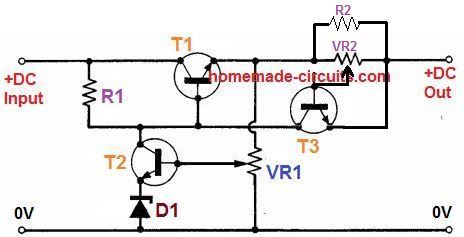
see how T3 is configured, you can include the same concept in the design specified by you!
Ok sir and thanks for reply.Your mentioned circuit seems fantastic but where it to be included ,is it at the extreme output side of Lm 317(after the pass transistor stage ) or any where between? For a variable supply of 0 to 30v and current from 0 to 2 amps, could you give the exact transistor types for T1,T2 and T3? so that i can almost calculate the values and power ratings of the resistors. What shall be the wattage of the zener also?
Binoj, you can add the current control in the following way:
The transistor can be a BC547.
RX indicates the current control resistor, it can be calculated as per the given formula in the diagram.
How would one implement the minus 6 to 12 volt supply for the LM301?
you can get through another opamp as shown in the following diagram:
" rel="ugc">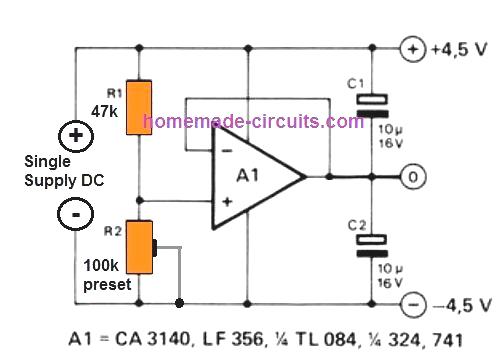
Ok thank you, I was wondering if an ICL 7660 would work?
yes that’s another good option.
Hi Swagatam
In this over current protection circuit using the BC547 and some resistors in parallel with the 10 k preset and calculate the Ry value, in your example you show for 10amps its 10x 0.7which is 7 watts, as high as being 10 amps or is it
10 x 0.07 which is 0.7 watts or a 1 watt
Just my doubt
Thanks Swagatam
Vee
Hi Vee,
It is 7 watts. 0.7 is minimum voltage required across the Ry resistor, and 10 amp is the maximum current limit, so the resistor wattage should be 7 watts
Hello sir thank you for these designs. For the Adjustable Voltage/Current LM317 High Current Regulator, what should I set the negative voltage into the op-amp? So I need a 337 regulator just for that voltage? Also, to do this to a bipolar supply, would I just reverse the caps, and the diodes, led. And of course power supply connections to the op-amp?
Hello Tony, you can use an 7905 IC and configure to get a desired -5V, or you the other variants like 7909 etc
However, for this you may also need the input supply source from a 24-0-12 transformer
Hi wanting to put two mosfets in parallel, how much does the mosfet activation resistance rx affect with the second mosfet in parallel
Hi, there will no effect since FETs are high input impedance devices, so the same Rx can work with the 2 devices.
Dear Sir,
please could you help me – can I use in the last circuit MOSFET IRF5210PBF for make a regulated power supply 1,2-30 V and 0-30 A DC? Or it is better to use a pair of BJT transistors in parallel (for example MJ15004). And I have o lot of LM338, it is better to use LM338 instead of LM317? (I don´t know – for stability?).
Hello Ervin, you can try it. R1 may need to be modified a bit, may be increased to 100 ohms. First try with a BJT, once the working is confirmed, you an replace the BJT with a MOSFET and modify R1 accordingly
Hello Swagatam, so I use powerful MOSFET IXTK170P10P, which withstands power loss up to 890 W. For a 15 A current I use 100 k pot and also resistors have different values (470 k versus 330 k). When I use o 100 ohm resistor for Gate voltage LM317T is almost cold. But there is problem with current stabilisation. Whend I used C3 and C8 = 10 microfarads, the whole system starts to oscillate with about 1 Hz. So I used C3 = 100 microF and C8 = 100 nF. Now it is stable, but when the current reaches setted value, the LM301 jump to -2 Volts on its output and LM317 will close 🙁 Two times it works perfectly, current stabilization kept the current precisely without differences (during testing and short circuit), but I do not know, why is it so unpredictable. Thanks for your answer.
Thank you Ervin, for trying the last circuit almost successfully, however for me it can be difficult diagnose the fault, basically since it was designed by the datasheet engineers, and second it has quite many parts with a negative voltage on the op amp pin4.
I think you can first try the circuit with a PNP BJT first and see how it performs in terms of stability! Otherwise the last option would be to go for the 4rth circuit which looks more convenient and cutomizable.
Hi,
Do I need to install LM317 on a heatsink in this current boosting circuit? I am assuming that all the current will go through the MOSFET therefore LM317 won’t heat up at all or not that much. Am I right or wrong? If heatsink is still needed for LM317, how big should it be?
Hi, it will depend on the Rx value, if it is large enough to allow only a few 100mA through the LM317, then heatsink will not be required
Hi, in reference to schema: “Adjustable Voltage/Current LM317 High Current Regulator”: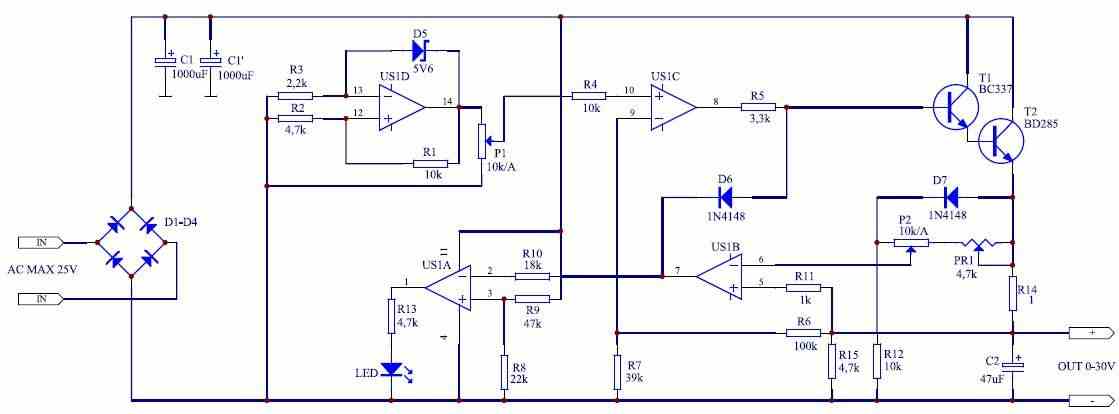 . The old one has low current capabilities (max 1A – but i have never got so much from this) and it is vulnerable to noises.
. The old one has low current capabilities (max 1A – but i have never got so much from this) and it is vulnerable to noises.
Do you consider it as a laboratory power supply? I mean, could you tell me how accurate it can be setting for example voltage/current off load and testing it on load? I consider powering it with transformator 230V->35V with bridge rectifier and capacitors but I am looking for information if it could be better than my old one " rel="ugc">
By the way, good job. I really appreciate your work. I couldn’t find anything what would be so useful and versatile as your article.
Hi, yes definitely you can use it as a lab power supply
Hi, In your post a circuit for “High current adjustable regulator circuit ” is published using LM317, TIP73, 2N2905, in the diagram other passive component values are clearly marked except two resistors one variable other fixed. Please do specify .
Also for my use I need to make an Bench Power supply of 0-30v ,0-10A regulated ; Please suggest suitably .
Hi, you can use 2.2k for the right side resistor, and 10k preset or pot for the variable resistor.
for the work bench power supply you can try the following concept:
https://www.homemade-circuits.com/lm317-variable-switch-mode-power-supply/
For 10 amps you will have to upgrade the outboard transistor with a TIP36 transistor, and also use an appropriately calculated thicker wire for the shown inductor.
Hi Mr Swagatam;
my input voltage is about either 12 volt dc or 14 volt. I need to boost those to 20-25 or 30 volts dc and max. 5 ampheres. Please advise an circuit I should use. Thanks
Hi Suat, if voltage increases then the current will go down proportionately.
to get 5 amps at 25V, the input 12V should be rated at 10 amps.
Hi Swagatam;
My input voltage is 14 v and amphere is about 20 amphere(from the source amt-s240w-12 model) no problem. I think that is enough to support 5 ampheres at output-Thanks again
Suat, you can try the first circuit from this article:
https://www.homemade-circuits.com/12v-car-laptop-charger-circuit-using/
Swagatam, thanks for this great article
I am struggling to understand Texas Instrument’s original high-current implementation. It works, but there is no current limit in there, am I right? I tried to simulate their circuit but I can’t get wrap my mind around what they are trying to achieve with this. Your implementations seem very logical and clear – unlike that.
Thank you Dare, yes, the second last circuit doesn’t seem to have a current control protection. But the last circuit has it.
Swag, sorry for my lack of understanding. In your 547 based overcurrent and short circuit protection circuit, I see that the transistor emitter is connected to 0v. But the circuit also uses ground. What is the difference. I mean, if I use a Center Tapped 12-0-12 trafo and a bridge rectifier as my input DC Stage, which would give an input voltage of roughly 15 volts or so, where would I get the 0v transformer and where would the ground terminal be… Can you please help…
Prithwiraj, the ground symbol only denotes the common DC negative line and has nothing to do with any external grounding or earthing. You can use your transformer as 0-12V supply, or as 0-24V supply by appropriately configuring the wires with the bridge rectifier, and use the output from the bridge to power the indicated circuit designs.
Prithwiraj Bose, I think he’s adding a low-side shunt between transformer’s 0V and the GND of the rest of the circuit (Power GND). You do not connect 0V from the transformer directly to the ground, but you do it via the shunt, which develops voltage drop as the current through the connected circuit increases. In short – bad idea, if you ask me.
For a center tap full wave rectifier power supply, the center 0V wire can be connected to the point shown as 0V, and the common cathode of the diodes to the point marked +.
However, using a bridge rectifier is the recommended design, since transformer heat dissipation is minimum in a 4 diode bridge topology.
swagatam sir do u have any igbt or mosfet 12v dc to 40vdc 20amp ckt diagrams with help of atx transformer. note my requirment voltage 12v dc to 40v dc 20amp maximum.
hello Shree, you can try the first diagram from this article, but please note that you will have to optimize the coil correctly through trial and error, until you get the specified 48v from…remember, to get 40V 20 amp, your input must be 12 V 66 amp
https://www.homemade-circuits.com/12v-car-laptop-charger-circuit-using/
you will have to replace the 24V zener with a 40 V zener diode
swagatam sir i am requesting u in want dc to dc converter with atx transformer mosfets or igbts ckt diagram for 48vdc e bike. input 12v dc 26amp . and output 48v 26amp required .
Hello Sree, sorry I do not have this boost converter design at this moment with me. However if the voltage is increased the current will go down proportionately, in your case the 48V current will drop to 6.5 amps
Swagatam, I’d like to use the ” BJT for current control” to power a glow plug. Typical glow plugs are 1.5VDC and it takes about 3-4 amps to make them glow. I have a PIC16F628 that generates a PWM signal on an output pin. The max current the PIC can source is 20mA. Will this circuit work with the output of the PIC being at 3.3 or 5V? I want to use the PIC to sense 1000 to 2000 mS pulses from the receiver and turn on or off the PWM signal to the BJT current control input signal.
Thanks
Garry
Gary, for a BJT current controller driver, you can try the circuit which is explained in the following article. The LM317 design cannot be used for your application
https://www.homemade-circuits.com/universal-high-watt-led-current-limiter/
hi sir,
regarding the last circuit using bjt, cant it drive at least 12 amperes?
Hi David, for 12 amps you can replace TIP73 with two TIP142 in parallel and check the response….
hi, I’m a student
I need help to solve this problem
Q1: design 12v current boosted 3 terminal regulator consumes 8mA with current limitation at 3 A.
Q2: design positive adjustable regulator using LM317 500mA to supply load that varies in range (48-96V)
Hi, THe current limit can be achieved by implementing the second last concept, but I am not sure how to get 96V using a LM317
ok.thank you so much
hi brother,
i have doubt how negative volt will produce across to bias pnp transitor…..please explain…….
Hi, the (-) voltage is developed across Rx, due to the load connected at the output.
Good day sir, Swag, please i need a fixed voltage regulator to handle the ffg specs:
Input voltage-36v, output 5v
Output current 10amps.
I was thinking of using the 317 outboard circuit but it may vary the output voltage depending on input voltage. It will not produce fixed output voltage
Thanks
Adeyemi, LM317 will not vary the output even if the input is changed, but it must not exceed 36V. However at 5V the IC may get very hot…
Thanks Swag for your help, please the charging for phone is slow, can I also add the npn transistor in parallel.
Hi Adeyemi, please try the last circuit and see whether it speeds up the charging or not.
That’s what I used, is getting hot on heatsink can I add more npn transistors
Yes you can more NPN in parallel or you can use a Darlington instead
Please how do I do darlington with this circuit
You can use a ready made Darlington TIP122 on heatsink, it will allow 3 to 4 amp current max.
Thanks for your help, please in the last circuit where will I place tip122 and which one should remove.
TIP122 is NPN so it will be replace TIP73 in the last circuit
Hi Swagatam i’m right now doing a schema for a 900 mA current limiter whith a LM 317 but it’s not working. so can you please help with a schema for a 18V voltage 900 mA curent limiter? thanks
Esaie, please try the following circuit:
Use Rc = 0.7 / 0.9 = 0.77 Ohms 1 watt
R1 = 120 ohms,
Pot = 10K pot, linear
Hi Swagatam:
I was able to follow everything you did up until the circuit shown in 8.3.12. I understand what you di with resistor Rx in the earlier circuits but now there’s an additional resistor on the base of the 2N2905 and a 500 ohm resistor between the base and emitter of the TIP73. COuld you take a minute to explain their function and how their values are determined?
Thanks for a super site!
EBS
Hi Everett, the diagram is per the datasheet of the IC. The concept is similar to the one which is explained at the top, except the the extra NPN which reinforces the PNP to generate more current and an evenly distributed heat dissipation. They both complement each other to produce more current and less heat, that’s all, no other special feature is available from the last configuration
Hi swagatam first congratulation for your hard work .
i’m a hobbyist and i want to ask stupid question 🙂 with your design can i upgrade currant i mean from transformer 4 ampere can i have approximately 20 ampere ?
If not you have project or solution for simple project to have big currant low voltage ? 20amp transformer is so big not practical for the project i want to make thank good jobs br!
Thank you Issam, voltage and current can be changed using a transformer but the wattage will always remain the same. For example if you have a 4 amp 25 V supply, it can be changed into 5 V 20 amp. If you multiply the two V x I you get 100 watts on both sides, so it works in this way.
Hi Swag
Can I replace N-channel instead P-Ch,, and how ? Please
Hi Shaker, N channel won’t work, i am sorry.
Can I put several Mosfet irf9540 transistors in parallel?
Yes that’s possible…
Changes in the scheme are needed?
No changes are required for parallel mosfets, but please confirm with a single mosfet first, and only then proceed with more numbers.
Hello sir, i two questions to ask pls:
1. can i use TIP127? If yes how can i connect the pins to the circiut?
2. While the transistor increases the current, is the output current of the circuit equal the transistor’s current or it will be plus the ICs current? Thanks
1) You can use TIP127, pin connections will be similar to what is shown in the diagram.take the help of the datasheet of the transistor
2) The output current will be equal to the sum of both IC and the transistor
Hi Swagatam,
I would like to confirm with you the calculation of Rx & Ry.
I require 3A max ( even though the TIP34C are rated at 10A) from the power supply. I use a BJT (TIP34C) instead of a Mosfet in my circuit.
Therefore to calculate Rx & Ry I used the following calculations:
Rx = TIC34C Trig. V/LM317V Optimal Current
Rx = 0.7V/1A=0.7R
W = 0.7V x 1A=0.7W
Ry = Trig. V BC547+LED Forw. V/Current Limit TIP34C
Ry = 0.6V + 3.6V/3A = 1.40R
W = 4.2Vx3A = 12.6W
Are my calculations correct to achieve 3A output.
Your help will be much appreciated
Kind regards
Jan
Hi Jan, referring to the last diagram all your calculations look OK to me, the LED is supposed to be in series with the base resistor of BC547 which is shown as 47 ohm
Hi Swagatam,
In the following post you said the LED must be in series with the emitter of the BC547. Now you say it must be in series with the base resistor? How do I calculate Ry then?
Regards
Jan
Reply
Swagatam says
March 19, 2017 at 7:20 am
connecting it in series with the emitter will be a better idea and a resistor can be avoided.
but in that case make sure the Ry formula is modified in the following way:
Ry = 0.6 + LED fwd Voltage / current limit value
Hi Jan,
connect it with base, because connecting it with emitter will keep the ADJ pin always at 3.3V higher than ground, and never allow 0V at the output.
the calculation will be the same whether the LED is in emiter or base.
Thank you for your assistance. I really enjoy your site.
Regards
Jan
It’s my pleasure Jan!!
Hello, Mr. Swagatam.
Can I change the LM317 30v IC to the 60v LM317HVT to have a higher Vout and maintain the IRF9045?
Would something like Vout = 0 – 60v and Iout = 10 amp = +/- 600W!?
Thank you
Amadeu Mendes
Hi Amadeu, yes you can implement that, you will be able to get the mentioned amount of power at the output
Thank you.
You are the best…
Amdeu Mendes
you are most welcome Amadeu.
Hi swagatam, i wanna try this circuit, and i want to ask if is too complicated if i want to make it with adjustable current about 3amp.
i alway like your design
Thanks Fajar, It could be achieved by modifying the Rx stage of the last diagram as per the instructions provided in the following article:
https://www.homemade-circuits.com/?s=current+resistor
hi Swagatam i really like your blog and the way u answer the questions . Thank you very much i will try this circuit
Thanks Bingo! Wish you all the best
Hi! Thank you for this helpful article!
I wonder how much power is dissipated by the MOSFET. I think it is U * I where U is the input voltage minus the output voltage and I the current going through the transistor. Do you confirm ?
yes that's correct.
Thanks for providing such a clear and simple explanation of how the outboard transistor works with the lm317. I couldn't get my head round how the external transistor was able to provide the correct voltage alongside the lm317 now that I know, it seems so simple, thanks.
Thank for visiting my site, I am glad the above post could help you to solve your curiosity. Please keep posting
Hi Swag,
I used this circuit, because i tried to reach 5Amps max. Ry=0.14 Ohm.
But whenever i short circuit the output, the current goes 8-10Amps and the cut-off is not working.
I did a modification, connecting the Pot (10K) between collector and emitter on BC547 but still the same result. As i observed, whenever i do short circuit i don't have 0.7V on the base of BC547, but 0.55V. And on the collector voltage varies 1.6-2.5 depending of the position of the potentiometer.
Hi Nikola, you can try the second circuit and dimension Ry with some trial and error until the current is restricted at 6amps max.
Yes the the third design might require some improvement, because the BC547 set-up might not be able stop the mosfet from conducting completely.
0.55V is sometimes enough to enable a BC547 to conduct…
No the shown configuration in the last diagram is correct…the actual ground is supposed to be connected to Ry and the emitter of BC547 because the return path of the current must pass through Ry before reaching the transformer ground.
Hi, sorry I could not quite get your point, can you elaborate differently?
sir i am feeding the input pin of lm317 with 48V dc.. i need an output voltage of fixed 12V and 10A.. what modification i have to do ?
Moreover i dont have 0.07 ohm resistors with me.. the only resistors i am having are 3 no.s of 0.1 ohm 10 W resistors.. so please suggest a suitable circuit
RT, You can try the last circuit and calculate Ry as per the formula.
you can use many 0.1 in parallel which may yield 0.07 value approximately.
No other modification would be required according to me.
Hi sir,
i just want to ask ,
if what is the possible connection.
to achieve 13.4V with 800mA current limit,
thanks
Hi Em,
It is possible, but the following design will be more suitable:
https://www.homemade-circuits.com/2012/02/how-to-make-current-controlled-12-volt.html
Hi Swa,
how are you ?
If i want to put an LED as short circuit indicator in series with the BC 547 collector, do we need to put a resistor in series to the LED? If so, how big is the value of the resistor?
Thanks
Kanta
Hi Kanta,
No it won't be required according to me.
Hi sir, can i used a LM2940CT 12 Volt 1 Amp Low Dropout Regulator instead of LM317? thanks sir
Hi Em, yes it will do!
could you use a poly fuse for short circuit protection
it's not required
The last circuit design link seems to be broken, so I cannot see the circuit please upload a new one..And I think heatsink would be required to LM317 as well.
It is perfectly opening and visible to me here, just click on the diagram to enlarge it.
sir what is the maximum current which can flow through this circuit.
It'll be as per your desired specs and requirement…
Is this circuit tested and confirmed
yes…
Hi Swagatham
An LED or a Piezo buzer with internel ocilator can be added to indicate the short circuit condition. Where can I connect it in the last diagram.
Can I use an N-channel mosfet instead of P-channel after some modifications in the circuit….? If yes, how.
Hi Anil, using an NPN transistor will make the design very complex, so PNP is the only easier option…connecting a buzzer will be difficult because there's no appropriate space for it in the above design, however you can use a red LED in series with the BC547 collector for a short circuit indication.
resistor for the led on the collector of bc547 can alter the design? what is the voltage on the collector of 547 transistor and how can I calculate the resistor for the led?
connecting it in series with the emitter will be a better idea and a resistor can be avoided.
but in that case make sure the Ry formula is modified in the following way:
Ry = 0.6 + LED fwd Voltage / current limit value
Hi Swagatam
Many thanks for this circuit. This circuit will be very useful for every electronic technicians, especially for beginers.
Hi Anil, It's my pleasure and thank you for suggesting me to post this important circuit concept.
Thanks for this. Note thought that near the begging you write "Rx = 10/1mA" but your description says 1A, not 1mA.
OK thanks, that looks like a typo, I'll correct it soon…